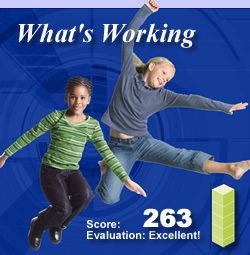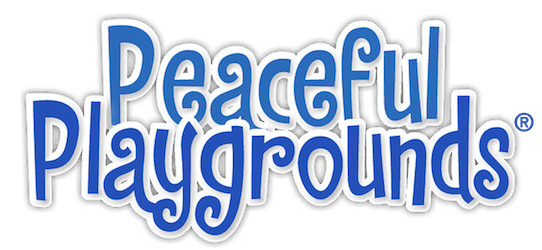What’s Working – Peaceful Playgrounds Best in Class

Action for Healthy Kids
National Evaluation – Excellent
August 2006
Peaceful Playgrounds
Peaceful Playgrounds (PPP) is a school based physical activity program with the goals and research support that has shown an increase children’s physical activity level, decrease in bullying and decrease in playground injuries.
Program Purpose
Peaceful Playgrounds addresses a number of national standards as identified by the following organizations:
Action for Healthy Kids Goals –
Provide daily recess periods for elementary school students, featuring time for unstructured but supervised active play.
Encourage the use of school facilities for physical activity programs offered by the school and/or community-based organizations outside of school hours.
These goals are met as Peaceful Playgrounds is a recess and after school program described best in April 2003 Parent Teachers Organization magazine as ” Peaceful Playgrounds concept takes a resource most playgrounds already have-open space-and transforms blacktops and fields into play areas for different age groups with activities such as tether ball, wall ball and Frisbee golf.”
Professional Standards that Peaceful Playgrounds addresses:
Physical activity has been identified as one of our nation’s leading health indicators in Healthy People 2010 and Peaceful Playgrounds Program addresses this national goal. It is recommended that children and adolescents participate in at least 60 minutes of moderate intensity physical activity most days of the week, preferably daily. CDC & USDA.
Target Audience The target audience is K-6 grade students in a school setting and has been successfully implemented in all socioeconomic situations and proven to be culturally sensitive and accepted in each setting. Evaluation/Monitoring Peaceful Playgrounds has participated in numerous studies that can be reviewed at: www.peacefulplayground.com/research.htm The SDCC study was conducted in conjunction with Dr. Thom McKenzie evaluator and designer for SPARK and CATCH programs. His SOPLAY validated instrument was used to determine the MVPA levels of students at recess in over 500 school site recess observation sessions. This research indicates that students were more physically active and drawn to the recess markings thus indicating that behavior was effected. Behavior- MVPA increased (evidence playground observation) Knowledge-students acquired knowledge in game rules, and sports skills (evidence game participation) Attitude- Attitude changes in a decrease in perception of bullying incidents ( documented in CA Healthy Kids Survey) Policy changes have varied per school site. Most policy changes occur in recess reinstatement. School Environment – Changes in physical environment documented in the playground repainting and adding games. Emotional environment changes as students report feeling safer in a “peaceful environment.” evidence recess surveys pre & post implementation of Peaceful Playgrounds). Participation Rate Over 8000 schools across the nation are in various stages of implementing Peaceful Playgrounds. It’s rapid expansions attests that the approach is both practical and a realistic intervention for schools interested in this cost effective childhood obesity intervention that gets kids moving. Internationally, various departments of health are implementing obesity prevention programs based on adding markings to school playgrounds (UK & Australia) Impact Research studies (San Diego Consortium PEP Grant Evaluation Report) documented that “more students were drawn to the playground markings which resulted in more active children.” Over 500 observational sessions by trained observes with SOPLAY a research validated instrument supported the notion that students found the markings both engaging and interacted with the new environment. -Additional research has documented that student acquire skills in conflict resolution, and acquire both knowledge in game rules and skills to participate in games. Application/Adoption 1. Peaceful Playgrounds has a website that supports implementation with a frequently ask questions webpage and on-demand webcast. Monthly newsletters (2500) keep constituents, stakeholders, and school community members updated on latest research and recommendations. A Peaceful Playgrounds implementation guide can be downloaded from website. A 40 hour a week toll free phone number is available. Website filled with free training materials, forms, offer more than 400 pages of support. 2. Training resources. Peaceful Playgrounds comes with a staff development component including an overview instructional video, a PowerPoint PPP presentation with facilitator notes, and participant handouts. Website has downloadable materials as well. 3. Technical Support/Additional resources: Website, 800 phone number, web information request, e mail distribution list of newsletter recipients sent monthly, parent materials all round out the level of support provided by Peaceful Playgrounds. 4. Instructions/Materials in Languages in addition to English-Translation of parent newsletters in Spanish in progress. School Goals and Student Achievement Peaceful Playgrounds fits into required school mandates in CA as recess is mandated in CA Ed. Code. It also contributes to the recommended 30-60 minutes daily of physical activity as required by the CA Supt. Task Force on Childhood Obesity Prevention. Additionally, CA fitness results indicated that there is a relationship between the fitness performance and academic achievement. The Peaceful Playgrounds Program contributes to the well being and fitness through increasing students in MVPA. Curriculum Integration Peaceful Playgrounds has been shown to easily be integrated in to classroom practice though the use of the problem solving techniques adapted school wide in most settings. With recess built into the school day, enhancing recess is readily accepted and enthusiastically implemented. Peaceful Playgrounds fulfills the PA component in a Coordinated School Health Program. Most schools also implement the concepts in the before and after school settings as well. Stakeholder Support Peaceful Playgrounds is a school wide program that when properly implemented brings about whole school change. At best the entire staff is trained and plays a role in consistent student behavior expectations. A strong base of support is cultivated through an awareness session discussing the playground problems that currently need to be addressed and the lack of positive interventions available to schools. When schools realize that the playground will be more peaceful, students will solve problems appropriately, bullying is decreased they learn that they have fewer interruptions to the classroom learning environment and students have the ability to be active resulting in more attentive students. Sustainability Sustainability is achieved through the painted markings which last on average 5-7 years. Research indicated that students will spread out over the play space thus reducing confrontations, pick a less preferred game, be more active, experience bullying less frequently in this environment. Program Categories Achievement – Advertising + Marketing in Schools – Childhood Obesity – Co-Curricular Programs – Community Family Outreach – Coordinated School Health Program – Guidelines + Policies + Recommendations – Minority Outreach Programs – Physical Education – Physical Activity – Children’s Health and Nutrition – Changing the School Environment.


